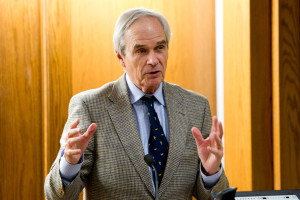
Verkuil’s proposal for replacing contractors with professional bureaucrats is unlikely to be adopted.
In Valuing Bureaucracy: The Case for Professional Government, Paul R. Verkuil notes that the number of federal civil servants has not increased in decades—it is now at the level it was during the Kennedy Administration. All growth in the federal workforce has been through the addition of contractors. Verkuil argues passionately and persuasively that we should change this situation and return to a federal workforce that consists primarily of professional bureaucrats. He recognizes, however, that such a change would not benefit the country without major changes to the civil service system.
I agree with Verkuil, but he is waging a quixotic campaign. The changes he urges cannot happen for many reasons.
First, neither political party will support such a change. As Verkuil acknowledges, Republicans want to decrease significantly the number of federal civil servants, while Democrats want to retain the number we have today. There is no chance that a compromise between the political parties can yield the results that Verkuil urges.
Second, an expansion of the number of civil servants cannot take place because neither politicians nor the public trust civil servants. Scandals like the Flint drinking water disaster, the Internal Revenue Service’s delay of approval of the 501(c)(4) applications of conservative organizations until after the 2012 election, and the revelation that gross mismanagement at the the U.S. Department of Veterans Affairs resulted in the tragic deaths of dozens of veterans after their requests for treatment were placed in a closet for years have not instilled confidence in federal bureaucrats.
I do not think these incidents are representative of the fruits of the labor of federal civil servants. In my experience, the federal bureaucracy produces good results in the vast majority of circumstances. My views on this subject are irrelevant, however. What matters is the widespread perception of politicians and the general public that federal bureaucrats cannot be trusted.
Third, the major reforms to the civil service system that Verkuil identifies as an essential prerequisite to the success of his proposal are highly unlikely to occur. As he notes, civil servants would have to be paid far more to allow the federal government to hire even the graduates of the major public policy schools that were founded to educate a class of federal bureaucrats. The vast majority of those graduates will continue to take the far more lucrative offers they get from federal contractors. There is little chance that Congress will change that situation when both politicians and the general public distrust federal bureaucrats.
Fourth, civil service reforms—for example, an expansion of the Senior Executive Service (SES)—are unlikely to produce the improvements that Verkuil attributes to them. They are more likely to backfire and to place the best of the federal bureaucrats in an untenable situation. Verkuil points to the creation of the SES as an illustration of potentially beneficial reforms. He acknowledges that SES has not yet realized its full potential and urges “reforms to the SES that will allow that crucial body of officials to manage government effectively and at the highest levels.”
Verkuil’s aspirations for a strengthened SES have been overtaken by subsequent events. In July 2017, the U.S. Department of the Interior involuntarily transferred fifty senior scientists to the bureaucratic equivalent of Siberia because the scientists had the temerity to speak out publicly about the dangers of climate change. When asked about this “reallocation” of personnel, an Interior Department spokesperson reportedly said that members of the SES “signed up for the SES knowing that they could be called upon to work in different positions at any time.” The number of people who sign up for SES is certain to decline dramatically now that federal civil servants appreciate the substantial risk that a decision to join the SES can lead to the end of a meaningful career in government.
I will close my dismal prediction about the fate of Verkuil’s bold proposal with a comment on his well-supported argument that agencies need to improve their coordination. The now-defunct Clean Power Plan (CPP) is a good illustration of the critical need for better coordination. As Emily Hammond and I have explained, the CPP was unlikely to have its desired effects if it had been allowed to go into effect.
The root of the many serious practical problems with any attempt to implement the CPP was lack of inter-agency coordination. In the CPP, the U.S. Environmental Protection Agency (EPA) attempted to change dramatically the manner in which electricity is generated and transmitted. Unfortunately, EPA knows nothing about the incredibly complicated manner in which the U.S. electricity grid operates.
When I spent a day explaining the CPP to the staff of the Federal Energy Regulatory Commission (FERC) shortly after EPA announced the CPP, they were surprised to learn that EPA simply assumed that FERC could and would make the massive changes in the operation of the grid that EPA implicitly assumed as a necessary predicate for the success of the CPP. As the agency responsible for regulating the grid, FERC had no idea whether or how it could change its regulatory approach to be compatible with the ambitious goals of the CPP.
It would have been nice if EPA had coordinated its attempt to change the operation of the electricity grid with the agency that is responsible for regulating the grid. Even that would not have been sufficient, however, to ensure that the CPP would have its desired effect. As with so many other important subjects, no employee of any federal agency has the level of expertise about the functioning of the grid needed to help EPA craft a version of the CPP that would be compatible with the way the grid operates. EPA should have hired an outside expert—a contractor, like Bill Hogan at Harvard Kennedy School or Paul Joskow at the Massachusetts Institute of Technology—to assist it in performing this daunting task. This anecdote illustrates the critical roles that contractors must play in helping agencies make well-informed decisions in the real world in which agencies must function.
This essay is part of a nine-part series, entitled Valuing Professional Government.




